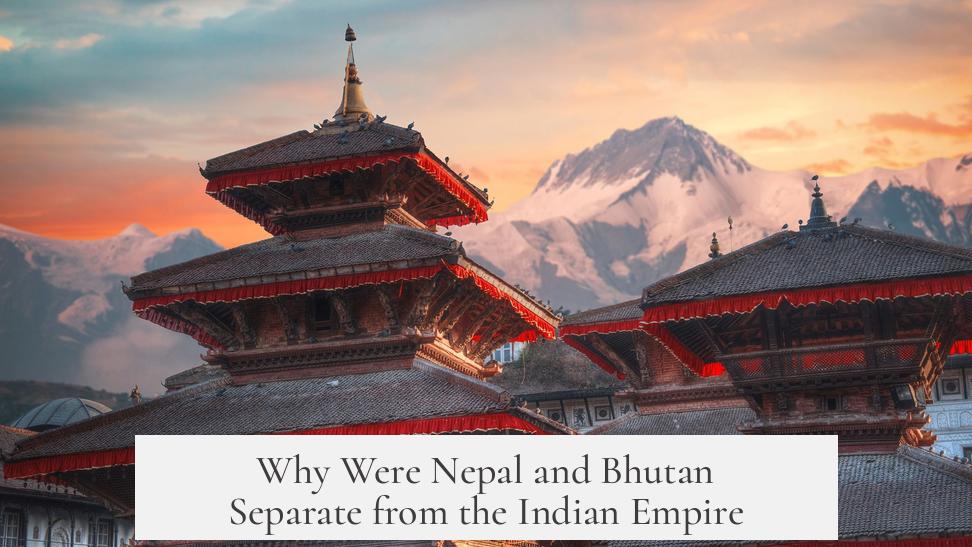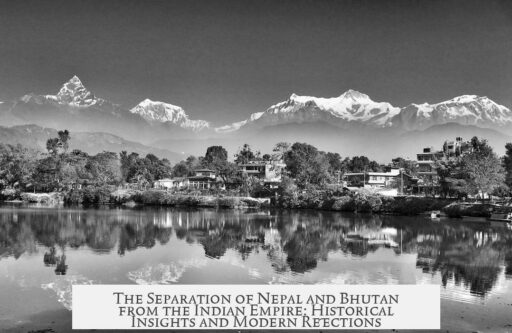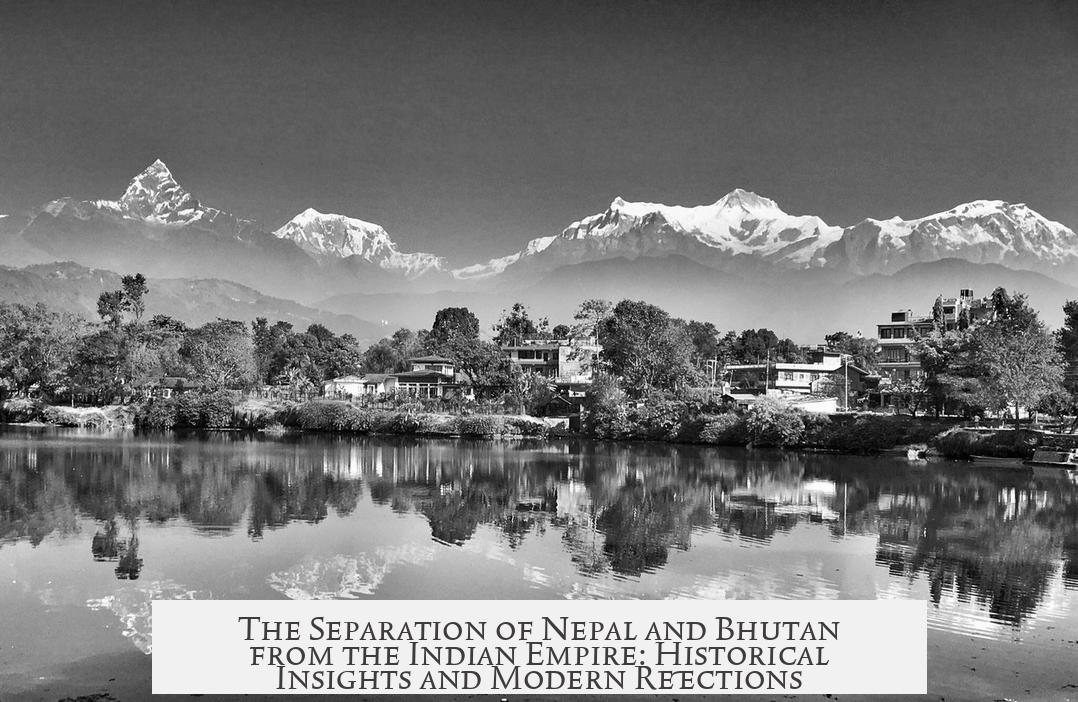Nepal and Bhutan remained separate from the Indian Empire primarily due to their political status as sovereign kingdoms, strategic British interests, difficult geography, and their roles as buffer states during British rule in India.
Nepal and Bhutan were not treated as typical princely states like Hyderabad or Kashmir. Instead, their rulers regarded themselves as equals to the heads of government in British India and later Pakistan. Both kingdoms retained significant autonomy despite British influence, which was exercised mainly through indirect means such as diplomatic Residents rather than full annexation or direct governance.
British priorities in India centered on securing trade routes, managing geopolitical rivalry with Russia—the so-called “Great Game”—and exploiting profitable economic activities like tea cultivation. Control over Tibet trade routes had declined sharply after the Opium Wars, which made the trade through Tibet to China obsolete and not worth the cost of direct rule over the Himalayan kingdoms. British interest in Nepal and Bhutan literally focused more on liquidity and strategic oversight rather than territorial conquest or resource extraction from their mountainous interiors.
The military history of the British campaigns in the region illustrates why direct conquest was avoided. The Gurkha Wars against Nepal and the Duar War involving Bhutan showed that, although the British could defeat these states in battle, occupying and controlling these rugged and high-altitude territories proved impractical. The challenging terrain, including malarial jungles and high mountain passes, combined with logistical difficulties, made sustained military occupation costly and inefficient.
The British response was to incorporate Nepal and Bhutan into their sphere of influence through treaties granting them some territorial concessions—frequently of economically valuable lowlands suitable for tea plantations—while leaving their core sovereign structures intact. This arrangement allowed the British to keep the Russians at bay while minimizing the difficulties of direct rule over inaccessible terrain.
| Factor | Explanation |
|---|---|
| Political Autonomy | Rulers of Nepal and Bhutan saw themselves as equals to British Indian heads, not as princely subjects. |
| Strategic Interests | Focus on trade routes to China declined; primary concern was preventing Russian advances. |
| Military Challenges | Difficult terrain and disease deterred British from direct occupation despite victories. |
| Buffer Role | Nepal acted as a friendly barrier between British India and China. |
| Economic Value | Lowland areas were ceded for tea plantations, but mountains held limited economic appeal. |
Nepal signed a series of treaties with the British East India Company after its defeat in early 19th century conflicts. These treaties resulted in territorial losses for Nepal and the establishment of a British Resident, signaling close diplomatic ties, but Nepal retained formal independence. It served as an effective buffer protecting British India from Chinese expansion without requiring British administration.
Bhutan’s situation mirrored Nepal’s in some ways but evolved differently after Indian independence. Although briefly treated like a princely state under British India, Bhutan declared independence following Indian sovereignty in 1947. India, unlike with Hyderabad and Goa, chose not to invade or annex Bhutan, allowing it to remain an independent kingdom. This outcome reflects Bhutan’s distinct political traditions and the pragmatic choices of both British and Indian policymakers.
The British Empire viewed the Himalayan kingdoms as strategically important yet costly to directly control. The terrain impeded military campaigns; logistical obstacles and health risks such as malaria discouraged prolonged occupation attempts. The British assessed that Russian invasion through Nepal or Bhutan was unlikely, reducing the need for direct oversight.
This combination of respect for sovereign rule, geographic barriers, limited economic gains from mountainous lands, and strategic calculation to prevent Russian influence explains why Nepal and Bhutan remained separate from British India.
- Nepal and Bhutan maintained sovereign status, unlike other princely states.
- British priority was trade and strategic borders, not full conquest.
- Mountainous terrain and disease limited military occupation.
- Both kingdoms served as buffers against Chinese and Russian expansion.
- Lowlands ceded for tea plantations, but mountains lacked direct economic value.
- Bhutan achieved full independence post-1947 without annexation.
Why Were Nepal and Bhutan Separate from the Indian Empire?

In a nutshell, Nepal and Bhutan stayed separate from the Indian Empire because their rulers were seen as peers, not mere princes, military logistics made full control difficult, and strategic reasons favored indirect influence instead of conquest. This fascinating dynamic springs from a mix of geography, politics, economics, and international rivalry. Let’s unpack this mountainous mystery step by step.
First, consider the rulers themselves. Unlike the princely states like Hyderabad or Kashmir, Nepal and Bhutan’s kings didn’t view themselves as minor territories under British colonial oversight. To them, they were equals to the new heads of government in British India and even Pakistan. Imagine being at a party where everyone is introduced as “prince” or “duke,” but these two show up claiming, “No, actually, we’re the kings here.” That’s the nuance missed by many who only lumped all these territories under one British umbrella. They were sovereign or quasi-sovereign states, just with a special relationship with the British.
Now, why didn’t the British just annex these kingdoms outright? The answer lies in strategic and economic calculations. The British Empire’s main interests during its rule in India were threefold:
- Keeping trade routes open to China;
- Winning the geopolitical chess match called the Great Game with Russia;
- And, quite simply, securing lucrative tea production.
However, the Tibet trade route to China, which once held significant promise, became obsolete after the Opium Wars. Suddenly, tea plantations in Assam and Darjeeling were much more important than trying to control difficult Himalayan passes. Nepal and Bhutan, nestled high in the Himalayas, weren’t profitable enough to justify costly direct rule.
The British did engage militarily with both kingdoms—the Gurkha Wars in Nepal and the Duar War in Bhutan—but these conflicts ended with British victories only insofar as territorial concessions and influence. Complete occupation? Nope. The terrain—steep, rugged, and often disease-ridden—was a nightmare to sustain an army in. In fact, even Napoleon’s 1800 campaign underscored the obstacles posed by jungles and mountains. Logistically, it made more sense to have local rulers with British advisors than to attempt costly conquest and control.
This strategy created buffer zones. Nepal, after its early 19th-century invasion of Bengal led to its defeat and a subsequent treaty, retained independence but ceded some territory and accepted a British resident. Nepal lay right on the northern border of British India. Friendly relations with Nepal provided a natural barrier against potential Chinese expansion. Who needs to micromanage sovereignty when a friendly neighbor is standing guard?
Bhutan’s story is a bit different but just as intriguing. It resembled the Indian princely states more closely than Nepal did. After India’s independence in 1947, both Bhutan and Hyderabad declared themselves independent sovereign states. The Indian government did move militarily into Hyderabad and Goa, but Bhutan was left alone. This was partly out of respect for Bhutan’s unique status and possibly due to the complexity involved—mountains and all. So Bhutan effectively became an independent state, recognized both politically and practically.
All told, the British Empire’s interest in the Himalayas reflected a delicate balance. They maintained control where economically and strategically necessary but didn’t overreach where it meant significant military and economic costs. The valuable lowland areas of Nepal and Bhutan were acquired in treaties and used for tea plantations, reflecting priorities at ground level rather than mountain peaks.
What Can We Learn from Their Separation?

This history tells us volumes about colonial strategy. It wasn’t just brute force or a “take all” mentality. Britain selectively engaged, considering terrain, existing power structures, and global rivalries like the tension with Russia.
Nepal and Bhutan, by maintaining their sovereignty or semi-sovereignty, secured positions as buffer states. Why? Because stability at the edges helped keep the big empire’s core safe. It’s a pragmatic strategy still echoed in modern geopolitics. Think of them as the advisory board members of the British Empire’s Himalayan chapter.
Reflecting on Strategy with a Modern Twist

One wonders what the world map would look like if the British had tried to govern Nepal and Bhutan directly. Would the tea in Darjeeling have turned out differently? Would the “Great Game” have played out along a different set of moves? The difficult terrain, diseases, and shifting geopolitics made these kingdoms frustrating and costly pawns to capture. So the British went for influence, not full control.
In today’s context, Nepal and Bhutan’s distinct political status has fostered unique cultural identities, and their historical independence has helped shape their modern political landscapes. The Himalayas remain majestic borders, symbols of tricky geopolitics rather than mere lines on a colonial map.
In Conclusion
Nepal and Bhutan were separate from the Indian Empire because of the unique status their rulers held, strategic economic priorities focused elsewhere, difficult terrain, and military limitations that made indirect control preferable. Their kings weren’t just “princes” to be commanded, but sovereign leaders to be respected. The British treated them as equals where it suited both parties, keeping them as buffers to greater powers and controlling the lowlands for resources like tea.
So, the next time you sip that fragrant cup of Darjeeling, remember the geopolitics simmering behind those tea fields. History brewed a blend of friendship, strategy, and respect at the top of the world, keeping Nepal and Bhutan proudly out of British India’s direct grasp.




